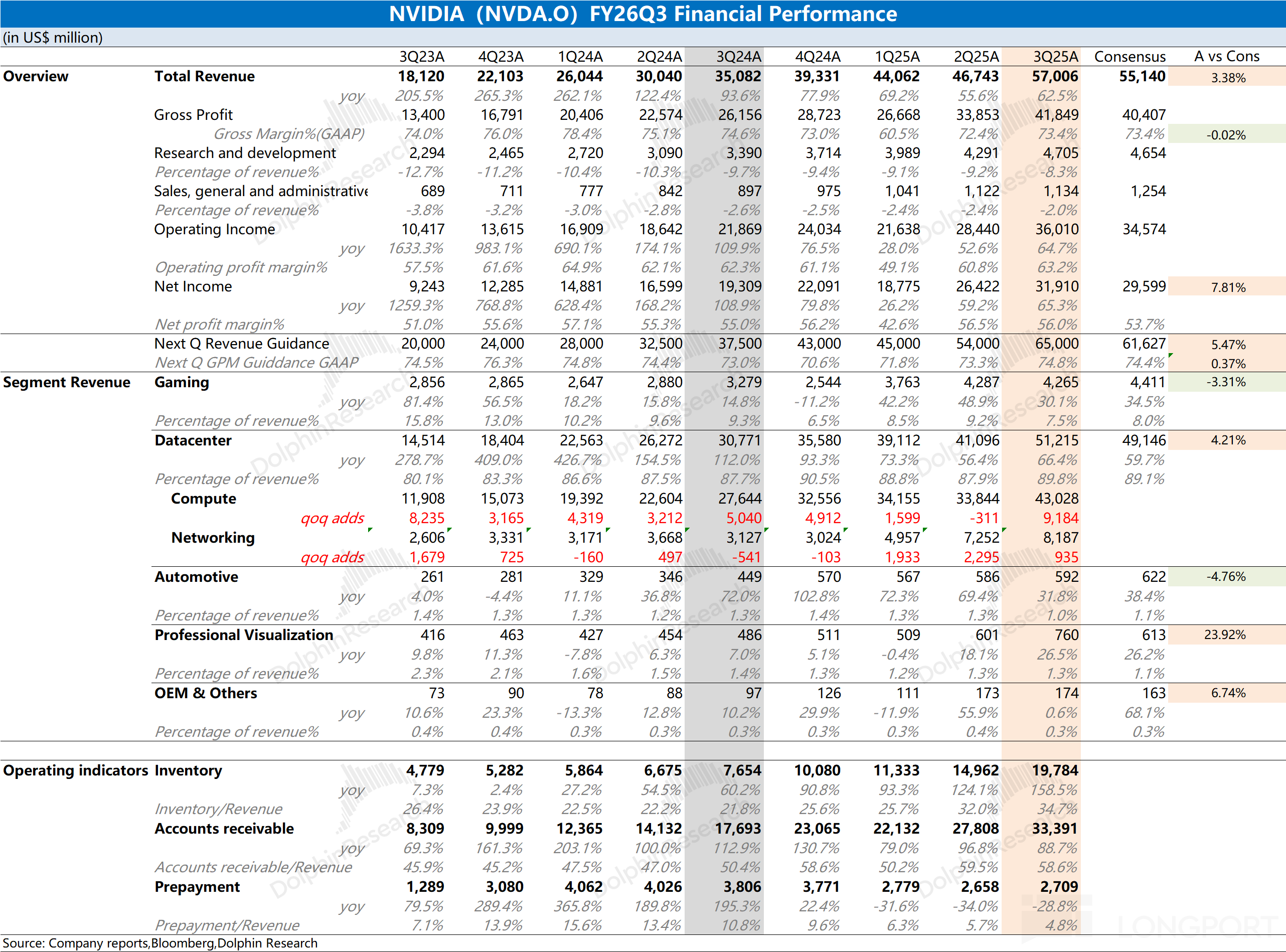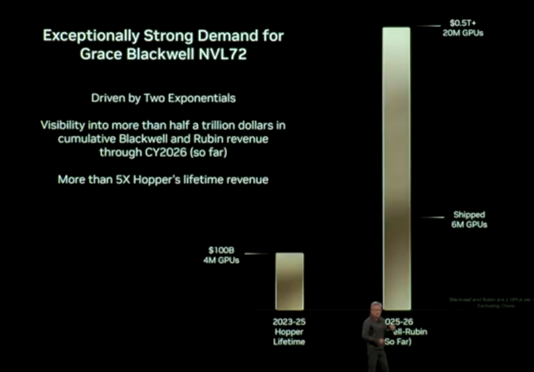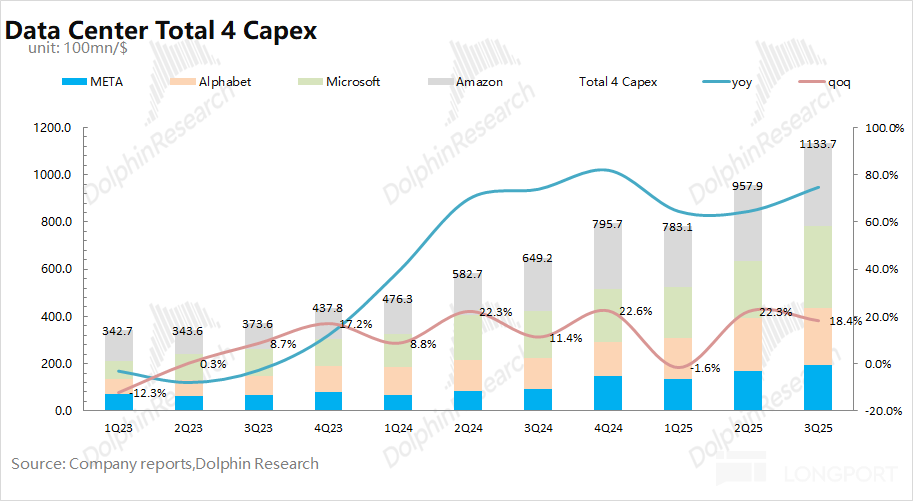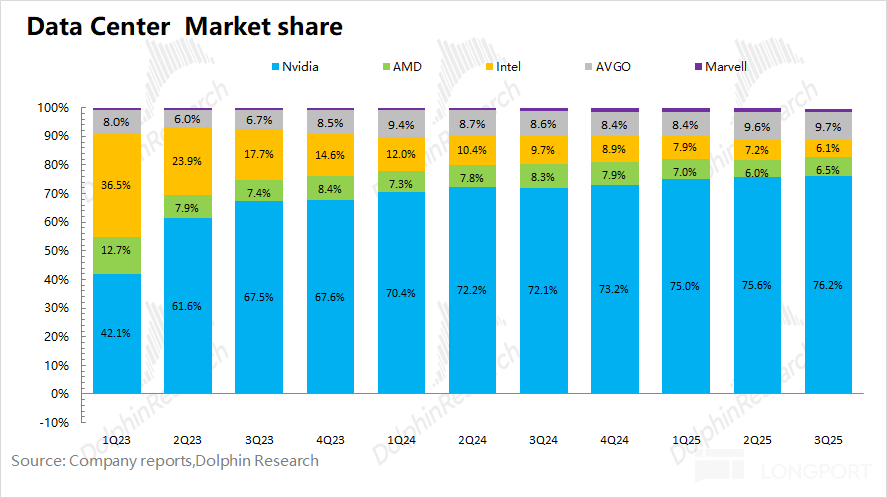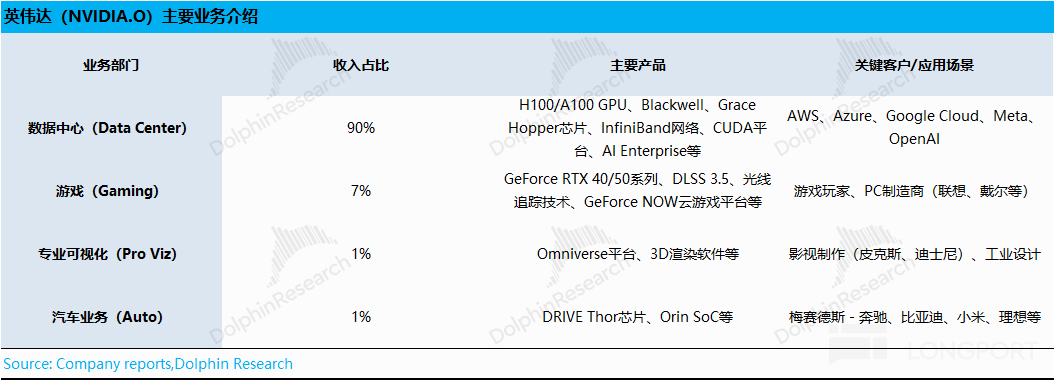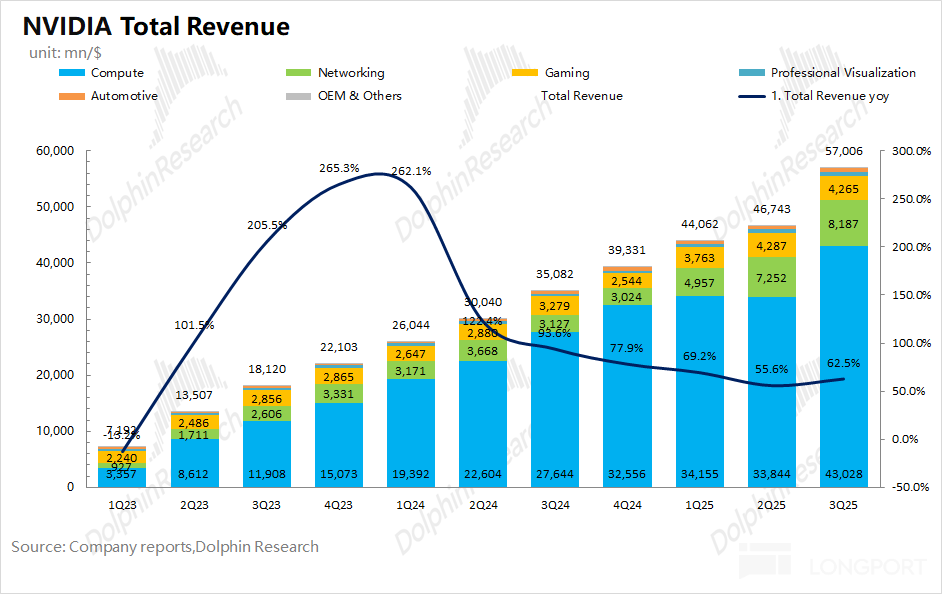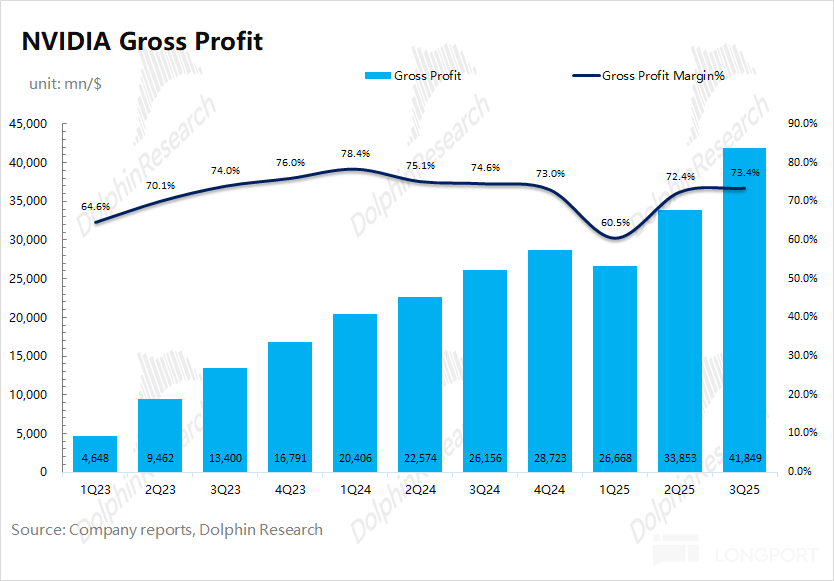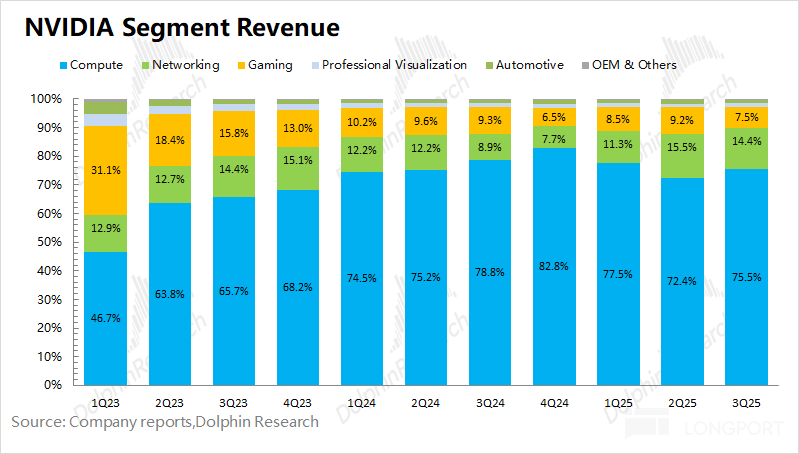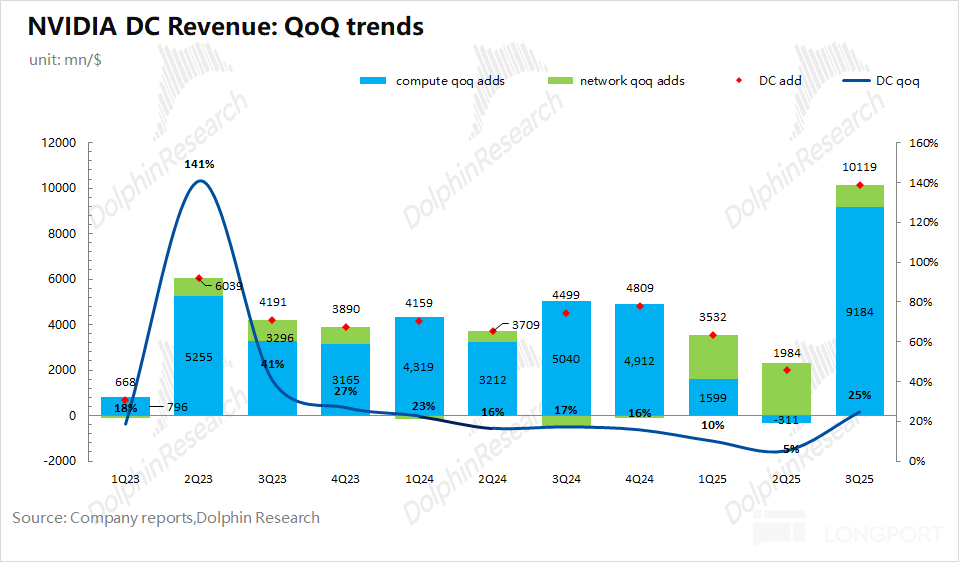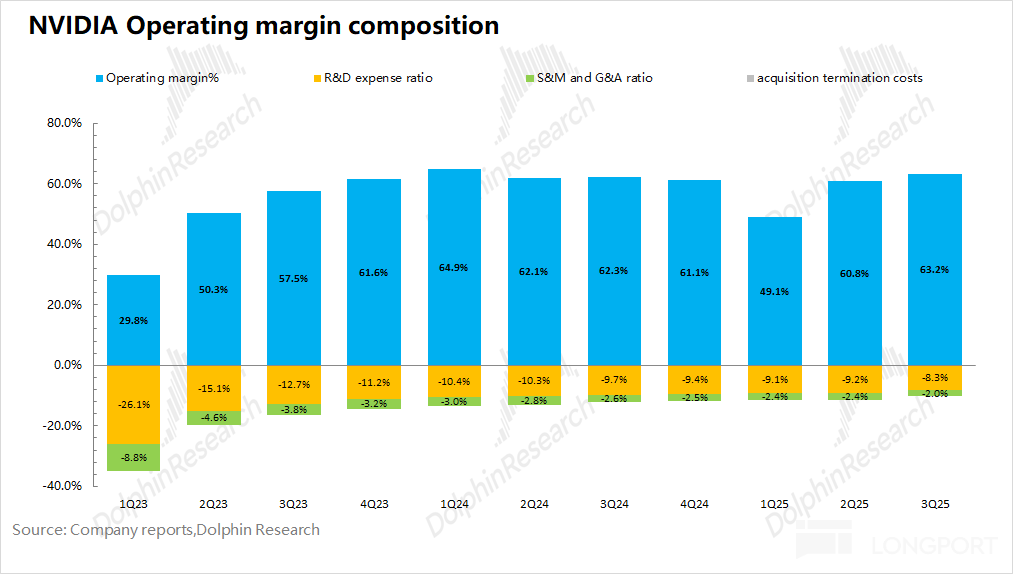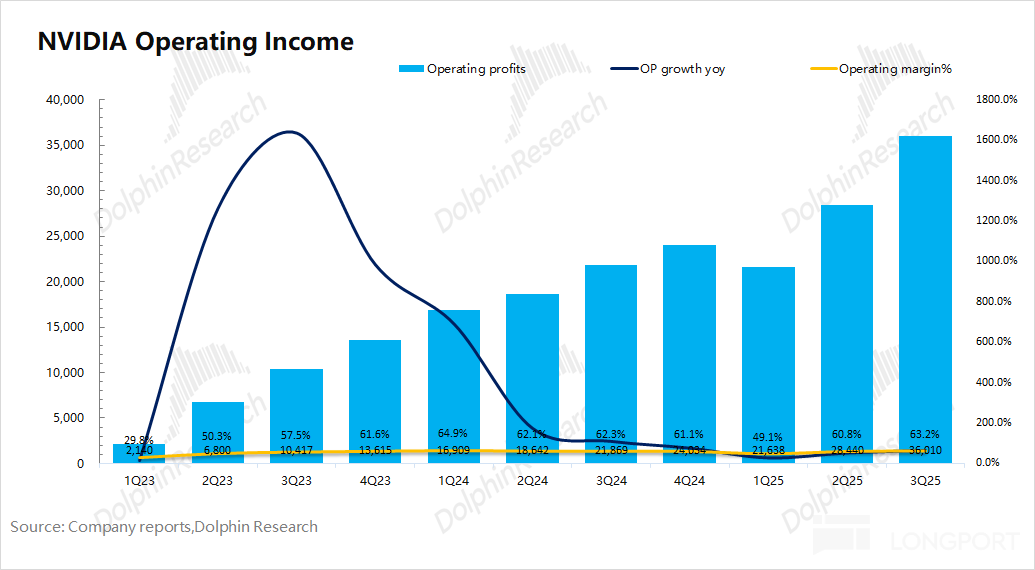
More Important than Non-Farm Payrolls! Can NVIDIA Save the U.S. Stock Market Again?

NVIDIA (NVDA.O) released its financial report for the third quarter of fiscal year 2026 (ending October 2025) in the early morning of November 20, Beijing time, after the U.S. stock market closed. The details are as follows:
1. Core Operating Indicators: $NVIDIA(NVDA.US) Total revenue of $57 billion, better than market expectations ($55.1 billion), with a quarter-on-quarter increase of $10.3 billion, mainly driven by the increased mass production of Blackwell in the data center business.
Gross margin of 73.4%, up 1 pct quarter-on-quarter, in line with market expectations. The gross margin was temporarily pressured during the transition period from Hopper to Blackwell, but it improved quarter-on-quarter as Blackwell's production capacity ramped up.
2. Data Center: This quarter's revenue was $51.2 billion, with a quarter-on-quarter increase of $10 billion, mainly due to the increased delivery of Blackwell chips. Currently, the Blackwell Ultra architecture has become the dominant architecture covering all customer categories, with the H20 product accounting for a negligible proportion.
In detail: This quarter's computing revenue was $43 billion, and network business revenue was $8.2 billion. The computing revenue this quarter increased by $9.2 billion quarter-on-quarter, being the largest increment in the company's revenue growth. The mass production ramp-up of B300 in the third quarter accelerated the overall growth of the Blackwell series.
3. Gaming Business: This quarter's revenue was $4.26 billion, up 30% year-on-year, benefiting from downstream demand for the company's RTX50 and other products. Compared to AMD's quarterly revenue of about $1.3 billion, NVIDIA still holds a significant advantage in the gaming graphics card market.
4. Profit: The company's core operating profit this quarter was $36 billion, up 65% year-on-year, mainly driven by rapid revenue growth and gross margin recovery. The core operating profit margin rebounded to 63%, benefiting from the profit space brought by the company's 70%+ gross margin level. With the increase in mass production of the GB series products, the company's core operating profit will continue to grow.
5. Next Quarter Guidance: The company expects revenue of $65 billion for the fourth quarter of fiscal year 2026 (i.e., 4Q25), without making assumptions about AI GPU revenue from the Chinese market, a quarter-on-quarter increase of $9 billion, better than market expectations ($61.6 billion); next quarter's gross margin (GAAP) is expected to be 74.8%, up 1.4 pct quarter-on-quarter, better than market expectations (74.4%). Driven by the ramp-up of GB series mass production, the company's performance will continue to improve.

Dolphin Research's Overall View: Behind the short-term "impressive" report card, more importantly, is the reassurance of medium- to long-term concerns
NVIDIA once again delivered better-than-expected results this quarter, especially with a quarter-on-quarter increase of $10 billion in revenue, which is quite impressive. The revenue growth this quarter was mainly driven by the increased mass production of the Blackwell series.
In addition, the company provided guidance for the next quarter, expecting revenue to reach $65 billion, a quarter-on-quarter increase of $8 billion, still better than the market's revised expectations ($63-64.5 billion), as the company is still driven by the Blackwell product cycle.
Since the company disclosed its AI business outlook at the previous GTC conference, it is expected that Blackwell+Rubin will reach a cumulative shipment guidance of 20 million units by the end of 2026 (roughly corresponding to $500 billion in revenue). It seems more like a quarterly distribution of $500 billion in revenue, and while faster booking will boost short-term market sentiment, attention must also be paid to the current long-term concerns of the market.
Compared to the better-than-expected performance and guidance, the market is actually more concerned about the impact of ASIC competition and customer self-research, the gross margin expectations at the end of 2026 and beyond, and the sustainability of downstream customer AI Capex.

Reviewing NVIDIA's stock price, it has actually been in the range of $160-185 for most of the time since August. During this period, the stock price broke through $200 and reached a high of $212, mainly due to the GTC conference at the end of October, which provided a shipment guidance of 20 million units for Blackwell+Rubin by the end of 2026, beating the market's expectations at the time (15 million units) by about 30%.
With SoftBank, Bridgewater, and other companies or institutions recently reported to have cleared or reduced their holdings of NVIDIA stock, this has somewhat shaken market confidence, and the stock price has fallen back to around $180.

In the current market with differences, the main focus of NVIDIA company:
a) Capital Expenditure of Major Companies (Main Buyers): Although Open AI has been quite aggressive in AI Capex since September, Open AI's business model and future cash flow remain very uncertain, and the current market has not considered this part of Open AI's increment too much.
Compared to Open AI, the market is more concerned about the capital expenditure situation of core cloud service giants. Several major companies have provided good capital expenditure outlooks after the third quarter reports, and downstream demand remains high growth.
Combining the capital expenditures and outlooks of various companies, Dolphin Research expects the capital expenditure of the four major core cloud companies (Google, Meta, Microsoft, and Amazon) to increase to $590 billion in 2026, a year-on-year increase of 42%.

Cloud service giants are the current main buyers of the company's AI chips and are the core "basic plate" of NVIDIA's performance growth, laying the foundation for the company's high growth next year.
[As for the sustainability of major companies' investments, economic efficiency (input-output ratio) must be considered. If all the money in the industry chain is earned by NVIDIA, then once the downstream economic efficiency is insufficient, it will affect the further investment of major companies, and the landing of downstream application scenarios can bring continuous improvement in capital expenditure.]
Open AI's long-term order agreement with NVIDIA for 10GW: Due to the uncertainty of Open AI itself, the market has not considered this too much. Because of the recent excessive circular trading, it has gradually been "rejected" by the market.
Including the recent signing of a $10 billion investment agreement with Anthropic by NVIDIA. However, it is somewhat comforting that the company explained that these investments are highly related to the final AI computing power deployment level of partners and the company's own liquidity and funding capabilities, with high investment uncertainty and may not all be implemented as planned.
b) Market Competition and Share Situation: If the data center revenue of various companies in the AI chip market is put together, NVIDIA still occupies more than 70% of the share, being the absolute leader in the industry.
This reflects NVIDIA's product advantages and brings high gross margins (70%+), but on the other hand, downstream customers may feel that all the money is earned by you, and will seek to develop their own chips/custom ASICs as lower-cost alternatives.

Google, Meta, Microsoft, Amazon, and Open AI have all started to develop their own AI chips, especially in the inference stage, where the gap between custom ASIC chips and NVIDIA GPUs is gradually narrowing, and the cost-effectiveness is becoming prominent.
The "Google Gemini + Broadcom" alliance poses a threat to NVIDIA's competitiveness in the AI market, potentially affecting NVIDIA's market share and gross margin in the AI chip market (the market is worried about a decline in gross margin in the second half of next year and beyond).
c) Progress of New Products: At the previous GTC conference, the company provided a roadmap for upcoming products.
NVIDIA plans to launch Rubin and CPX products in the second half of 2026, which will begin using TSMC's 3nm process, and will continue to launch Rubin Ultra products in 2027. It is also worth noting the new product progress information provided by the company's management after this financial report.


Referring to NVIDIA's current market value ($4.4 trillion), it corresponds to about 24 times PE of the company's net profit for fiscal year 2027 (assuming revenue growth of +53%, gross margin of 75%, and tax rate of 15.9%). Combined with the company's historical valuation and growth performance, the company's valuation does not seem high.
The market has not given NVIDIA a higher valuation mainly due to concerns about the decline in the company's AI chip market share after 2026, intensified competition, and the sustainability of AI Capex. Therefore, the market's valuation of NVIDIA is basically based on next year's performance, with significant differences and concerns about the operating performance after next year.
Since NVIDIA has already provided AI guidance until the end of 2026 at the GTC conference, the recent performance impact is not significant. Relatively speaking, what is more desired to see is how the company's management reassures the current market concerns, including changes in gross margin next year and beyond, cooperation and participation with large CSPs, expectations of ASIC competition and market share, etc.
On the other hand, sovereign AI and Open AI may also bring additional increments to the company, allowing the market to see more growth opportunities, but the company also needs to provide more explicit information to consolidate market confidence and help the company challenge $200 again. The most critical thing at present is that the company's management can eliminate market concerns and provide stronger responses regarding gross margin and market competition. Otherwise, even if there is continued "spicing" in areas such as sovereign AI and new customer progress, it will be difficult to gain sustained market confidence and achieve a real valuation increase. Please continue to follow Dolphin Research's subsequent management meeting minutes related content.
Dolphin Research's specific analysis of NVIDIA's financial report is detailed below:
I. NVIDIA's Business Situation
With the continuous growth of NVIDIA's data center, it has now become the largest part of the company's revenue, accounting for nearly 90%. The gaming business, which was previously the company's main source of revenue, has been compressed to about 10%.
Looking at specific businesses:
1) Data Center Business: It is the current main focus, with its main products including Blackwell, Hopper, and other computing power chips. The company's core customers are cloud service giants such as Amazon, Microsoft, and Google;
2) Gaming Business: The company remains a leader in the discrete graphics card market, with its current main products being the RTX40 and RTX50 series, and its main customers being gamers and PC manufacturers;
3) Professional Visualization and Automotive Business: These two businesses currently have a small share, both around 1-2%. The main customers of the professional visualization business include Pixar, Disney, etc. The automotive business mainly focuses on Orin chips and Thor chips, with customers mainly being car companies such as BYD, Xiaomi, and Li Auto.

II. Core Performance Indicators: Revenue Exceeds Expectations
2.1 Operating Revenue: In the third quarter of fiscal year 2026 (i.e., 3Q25), NVIDIA achieved revenue of $57 billion, up 62% year-on-year, better than market expectations ($55.1 billion). The company's quarter-on-quarter growth of $10 billion this quarter was mainly driven by the data center business and the mass production ramp-up of the Blackwell series.
Looking ahead to the next quarter, the company provided revenue guidance of $65 billion, a quarter-on-quarter increase of $8 billion, better than the market's revised expectations ($63-64.5 billion), still within the Blackwell product cycle.

2.2 Gross Margin (GAAP): In the third quarter of fiscal year 2026 (i.e., 3Q25), NVIDIA achieved a gross margin (GAAP) of 73.4%, in line with market expectations. The previous "flash crash" in the company's gross margin was mainly due to the impact of the H20 ban.
The current impact of H20 is no longer present, and the company's gross margin last quarter has rebounded to 72.4%, with a further quarter-on-quarter increase of 1 pct this quarter, mainly driven by the mass production ramp-up of Blackwell.
For the next quarter, the company expects a gross margin (GAAP) of 74.8%, slightly better than market expectations (74.4%). Driven by the mass production ramp-up of the GB series products, the company's gross margin is expected to return to above 75%.

III. Core Business Progress: Driven by the Blackwell Product Cycle
Driven by AI Capex, the revenue share of NVIDIA's data center business (Compute+Networking) has approached 90%, while the share of the gaming business has been squeezed to below 10%.

3.1 Data Center Business: In the third quarter of fiscal year 2026, NVIDIA's data center business achieved revenue of $51.2 billion, up 66% year-on-year. The data center business remains the company's biggest focus, with this quarter's growth mainly driven by the increased mass production of GB series products, driven by three major platforms—accelerated computing, powerful artificial intelligence (AI) models, and intelligent applications.

Specifically: ① Computing business revenue this quarter was $43 billion, with a quarter-on-quarter increase of $9.2 billion, with the accelerated mass production of B300 contributing the most significant increment; ② Network business revenue this quarter was $8.2 billion, with a quarter-on-quarter increase of $900 million.

Currently, cloud service providers remain the largest buyers of the company's AI chips, and thus the capital investment of downstream cloud providers forms the basis for the growth of the company's data center business. Through communication with the management of the four companies (Google, Meta, Microsoft, and Amazon), Dolphin Research expects the capital expenditure of the four major companies to reach nearly $590 billion in 2026, a year-on-year increase of 42%, which also provides a guarantee for the company's high growth next year.
As for the 10GW order reached with Open AI, it is estimated that this can bring about $350 billion in revenue. However, due to the many uncertainties in Open AI's business model and future cash flow, the market has not incorporated too many Open AI-related expectations, and the current core is still the procurement from cloud service giants.
On the other hand, the current core players in the AI chip market are NVIDIA, Broadcom, and AMD, which together occupy more than 90% of the market share. NVIDIA remains the absolute leader in the current market, but Broadcom and AMD continue to catch up with price advantages.
Since large models are divided into training and inference stages, although NVIDIA GPUs still have a significant advantage in the training stage, in the inference stage, where some performance requirements are lower, Broadcom's custom ASICs or AMD's products show significant cost-effectiveness advantages. As major companies start to develop their own chips, this is gradually becoming a concern for the market.
The impact of the "Gemini + Broadcom" alliance will challenge NVIDIA's market position and gross margin (75%). The high gross margin of upstream NVIDIA chips takes away a lot of profits from the industry chain, directly affecting downstream economic efficiency. If downstream economic efficiency is difficult to reflect, will customers continue to increase AI Capex in the future?
Therefore, from the perspective of the industry chain, with NVIDIA's ultra-high gross margin, all manufacturers have the motivation to develop their own chips or seek alternative solutions to achieve the "cost reduction" demand. Therefore, how long the company's current 75% gross margin can be maintained is also a concern and worry for the market, especially regarding the uncertainty of performance after fiscal year 2027.
3.2 Gaming Business: In the third quarter of fiscal year 2026, NVIDIA's gaming business achieved revenue of $4.26 billion, up 30% year-on-year, mainly driven by the shipment of the company's RTX50 and other series products. The gaming business now accounts for less than 10% of the company's total revenue, and the company's current performance focus remains on the data center business.
In terms of the gaming business, compared to AMD's gaming business quarterly revenue of $1.3 billion, NVIDIA still has a significant leading advantage in the gaming graphics card market.

IV. Main Financial Indicators: Profit Continues to Grow Under Scale Effect
4.1 Core Operating Profit Margin
In the third quarter of fiscal year 2026, NVIDIA's core operating profit margin was 63.2%, continuing to improve, mainly due to the recovery of gross margin and the decline in operating expense ratio.
Analyzing the composition of the core operating profit margin, the specific changes are as follows:
"Core Operating Profit Margin = Gross Margin - R&D Expense Ratio - Sales, Administrative, and Other Expense Ratio"
1) Gross Margin: This quarter was 73.4%, with a quarter-on-quarter increase of 1 pct, mainly benefiting from the mass production ramp-up of the Blackwell series products;
2) R&D Expense Ratio: This quarter was 8.3%. Although the company's R&D investment increased by $500 million quarter-on-quarter, the R&D expense ratio declined again due to the rapid growth in revenue;
3) Sales, Administrative, and Other Expense Ratio: During the Blackwell product cycle, the company's current sales and management expenses remain relatively stable, with the proportion in revenue declining to 2% this quarter.
The company expects the operating expense guidance for the next quarter to continue to rise to $6.7 billion, and combined with the revenue guidance, the operating expense ratio for the next quarter will continue to decline to 10.3%, continuing to be affected by the scale effect.

4.2 Core Operating Profit
In the third quarter of fiscal year 2026, NVIDIA's net profit was $31.9 billion, up 65% year-on-year. This quarter's net profit margin was 56%.
Since net profit is also affected by non-operating items, Dolphin Research is relatively more focused on the company's core operating profit (gross profit - R&D expenses - sales, administrative, and other expenses). The company's core operating profit this quarter was $36 billion, up 63% year-on-year. The core operating profit margin increased to 63%.
Currently in the Blackwell product cycle, with the increase in mass production of products such as B300, the company's performance is expected to grow quarter by quarter. Combined with the AI business outlook previously provided by the company, the company is expected to maintain rapid growth in fiscal year 2027.

<End Here>
Dolphin Research's historical articles on NVIDIA:
Recent Hot Topics
October 29, 2025, GTC Conference "GTC Conference: Next Year's Shipment "King Bomb", Is NVIDIA's Sky the Limit?"
September 10, 2025, CPX Launch "NVIDIA: Rubin CPX Debuts! Ready to Arm Wrestle with Broadcom ASIC"
September 1, 2025, Small Meeting "NVIDIA (Small Meeting): 2026 Target is Relatively Cautious, Market to Reach 3-4 Trillion by 2030"
Earnings Season
August 28, 2025, Conference Call "NVIDIA (Minutes): GB300 Already Shipped, Rubin to Mass Produce as Planned Next Year"
August 28, 2025, Earnings Review "NVIDIA: The Universe's Top Stock, Not Explosive Enough is a Sin?"
May 29, 2025, Conference Call "NVIDIA (Minutes): No Change in China's Shipment Ratio"
May 29, 2025, Earnings Review "NVIDIA: Don't Doubt, Still the Universe's Top Stock!"
February 27, 2025, Conference Call "NVIDIA (Minutes): No Change in China's Shipment Ratio"
February 27, 2025, Earnings Review "NVIDIA: Deepseek, Pierced Jensen Huang's "Leather Jacket"?"
November 21, 2024, Conference Call "NVIDIA: Blackwell Deliveries to Exceed Previous Expectations (FY25Q3 Conference Call)"
November 21, 2024, Earnings Review "NVIDIA is Still the Backbone, Just Reached Peak Firepower"
August 29, 2024, Conference Call "NVIDIA: Blackwell to Start Shipping in Q4 (FY25Q2 Conference Call)"
August 29, 2024, Earnings Review "NVIDIA: AI Faith Also Collapses, Honey Juice to Become Poison?"
May 23, 2024, Conference Call "NVIDIA: Sovereign AI to Bring Billions in Revenue (FY25Q1 Conference Call)"
May 23, 2024, Earnings Review "NVIDIA: "Universe" Strongest Stock, Gift Package Explodes Nonstop"
February 22, 2024, Conference Call "Accelerated Computing, Global Data Centers to Double (NVIDIA 4QFY24 Minutes)"
February 22, 2024, Earnings Review "NVIDIA: AI Stands Alone, The True King of Chips"
November 22, 2023, Conference Call "The First Wave of Artificial Intelligence (NVIDIA 3QFY24 Conference Call)"
November 22, 2023, Earnings Review "NVIDIA: Computing Power Tsar at Full Firepower? "Virtual Fire" Looms"
August 24, 2023, Conference Call "The Computing Revolution in the Name of "AI" (NVIDIA FY2Q24 Conference Call)"
August 24, 2023, Earnings Review "NVIDIA: Explosive Again, The "Solo Show" of the AI King"
May 25, 2023, Conference Call "Out of the Trough, Embracing the AI Era (NVIDIA FY24Q1 Conference Call)"
May 25, 2023, Earnings Review "Explosive NVIDIA: The AI New Era, The Future is Here"
February 23, 2023, Conference Call "Performance to Rebound After Bottoming Out, AI is the New Focus (NVIDIA FY23Q4 Conference Call)"
February 23, 2023, Earnings Review "Surviving the Cycle Tribulation, ChatGPT Returns NVIDIA's Faith"
November 18, 2022, Conference Call "Can the Continuously Rising Inventory be Digested Next Quarter? (NVIDIA FY2023Q3 Conference Call)"
November 18, 2022, Earnings Review "NVIDIA: Profits Slashed by Two-thirds, When Will the Turning Point Come?"
August 25, 2022, Conference Call "How Does Management Explain the "Flash Crash" in Gross Margin? (NVIDIA FY2023Q2 Conference Call)"
August 25, 2022, Earnings Review "NVIDIA Stuck in the Quagmire, Will It Rewalk 2018?"
August 8, 2022, Earnings Preview Review "Thunder Rolling, NVIDIA Performs "Free Fall" in Performance"
May 26, 2022, Conference Call "Pandemic and Lockdown, Gaming Decline Drags Down Second Quarter Performance (NVIDIA Conference Call)"
May 26, 2022, Earnings Review ""Pandemic Fat" is Gone, NVIDIA's Performance Looks Ugly"
February 17, 2022, Conference Call "NVIDIA: Multi-Chip Advancement, Data Center Becomes Company Focus (Conference Call Minutes)"
February 17, 2022, Earnings Review "NVIDIA: Hidden Concerns Behind Better-than-Expected Performance | Read the Financial Report"
November 18, 2021, Conference Call "How Does NVIDIA Build the Metaverse? Management: Focus on Omniverse (NVIDIA Conference Call)"
November 18, 2021, Earnings Review "Computing Power Profits, Metaverse Support, Will NVIDIA Keep Bullish?"
In-Depth
June 6, 2022 "U.S. Stock Market Turmoil, Were Apple, Tesla, and NVIDIA Wrongly Killed?"
February 28, 2022 "NVIDIA: High Growth is True, But the Cost-Effectiveness is Still Lacking"
December 6, 2021 "NVIDIA: Valuation Can't Be Supported by Imagination Alone"
September 16, 2021 "NVIDIA (Part 1): How Was the Chip Giant That Grew Twentyfold in Five Years Forged?"
September 28, 2021 "NVIDIA (Part 2): Dual-Engine Drive No Longer, Davis Double Kill Coming?"
The risk disclosure and statement of this article: Dolphin Research Disclaimer and General Disclosure
The copyright of this article belongs to the original author/organization.
The views expressed herein are solely those of the author and do not reflect the stance of the platform. The content is intended for investment reference purposes only and shall not be considered as investment advice. Please contact us if you have any questions or suggestions regarding the content services provided by the platform.

